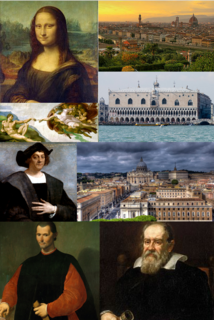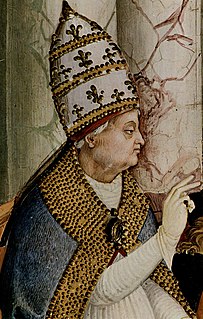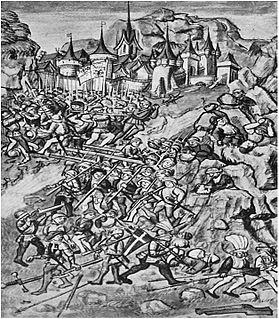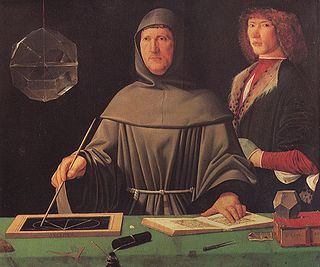 W
WThe cultural and artistic events of Italy during the period 1400 to 1499 are collectively referred to as the Quattrocento from the Italian word for the number 400, in turn from millequattrocento, which is Italian for the year 1400. The Quattrocento encompasses the artistic styles of the late Middle Ages, the early Renaissance, and the start of the High Renaissance, generally asserted to begin between 1495 and 1500.
 W
WThe Italian Renaissance, a period in Italian history that covered the 15th (Quattrocento) and 16th (Cinquecento) centuries, developed a culture that spread across Europe and marked the transition from the Middle Ages to modernity. The French word renaissance means "rebirth" and defines the period as one of cultural revival and renewed interest in classical antiquity after the centuries which Renaissance humanists labeled the "Dark Ages". The Renaissance author Giorgio Vasari used the term "Rebirth" in his Lives of the Most Excellent Painters, Sculptors, and Architects in 1550, but the concept became widespread only in the 19th century, after the work of scholars such as Jules Michelet and Jacob Burckhardt.
 W
WOn 27 November 1461, a powerful earthquake and series of aftershocks struck Italy's Abruzzo region along the Aterno River. The tremors caused widespread damage to Abruzzo's capital, L'Aquila, and the surrounding villages. At least 80 people are recorded to have died and numerous people were injured by the earthquakes. The quakes also caused major, permanent damage to religious sites and changed politics for L'Aquila and the Abruzzo region.
 W
WThe Battle of Arbedo was fought on June 30, 1422, between the Duchy of Milan and the Swiss Confederation.
 W
WThe Battle of Sant'Egidio was fought on 12 July 1416 at Sant'Egidio, near Umbertide between the condottiere Braccio da Montone and the troops of Perugia, under Carlo I Malatesta. Braccio's victory resulted in his long-desired conquest of Perugia, of which he became lord.
 W
WThe Battle of Bosco Marengo (aka Battle of Frascata) was fought in the Autumn of 1447.
 W
WThe Council of Mantua of 1459, or Congress of Mantua, was a religious meeting convoked by Pope Pius II, who had been elected to the Papacy in the previous year and was engaged in planning war against the Ottoman Turks, who had taken Constantinople in 1453. His call went out to the rulers of Europe, in an agonized plea to turn from internecine warfare to face Christendom's common enemy.
 W
WThe Battle of Crevola was fought in the spring of 1487, between a marauding Swiss army (from the Valais and Lucerne) and troops from the Duchy of Milan, for the supremacy of the Val d'Ossola (Eschental).
 W
WDe ludo scachorum, also known as Schifanoia, is a Latin-language manuscript on the game of chess written around 1500 by Luca Pacioli, a leading mathematician of the Renaissance. Created in the times when rules of the game were evolving to the ones known today, the manuscript contains over a hundred chess problems, to be solved – depending on the problem – using either the old or the modern rules.
 W
WIn the Battle of Giornico a Swiss force of 600 defeated 10,000 Milanese troops.
 W
WThe Golden Ambrosian Republic was a short-lived government founded in Milan by members of the University of Pavia with popular support, during the first phase of the Milanese War of Succession. With the aid of Francesco Sforza they held out against the forces of the Republic of Venice, but after a betrayal Sforza defected and captured Milan to become Duke himself, abolishing the Republic.
 W
WThe Guelphs and Ghibellines were factions supporting the Pope and the Holy Roman Emperor, respectively, in the Italian city-states of central and northern Italy. During the 12th and 13th centuries, rivalry between these two parties formed a particularly important aspect of the internal politics of medieval Italy. The struggle for power between the Papacy and the Holy Roman Empire arose with the Investiture Controversy, which began in 1075, and ended with the Concordat of Worms in 1122. The division between the Guelphs and Ghibellines in Italy, fuelled by the imperial Great Interregnum, persisted until the 15th century.
 W
WThe Italian Wars, often referred to as the Great Wars of Italy and sometimes as the Habsburg–Valois Wars, were a long series of wars fought between 1494 and 1559 in Italy during the Renaissance. The Italian peninsula, economically advanced but politically divided among several states, became the main battleground for European supremacy. The conflicts involved the major powers of Italy and Europe, in a series of events that followed the end of the 40-year long Peace of Lodi agreed in 1454 with the formation of the Italic League.
 W
WThe Medici Bank was a financial institution created by the Medici family in Italy during the 15th century (1397–1494). It was the largest and most respected bank in Europe during its prime. There are some estimates that the Medici family was, for a period of time, the wealthiest family in Europe. Estimating their wealth in today's money is difficult and imprecise, considering that they owned art, land, and gold. With this monetary wealth, the family acquired political power initially in Florence, and later in the wider spheres of Italy and Europe.
 W
WThe Republic of Ancona was a medieval commune and maritime republic notable for its economic development and maritime trade, particularly with the Byzantine Empire and Eastern Mediterranean, although somewhat confined by Venetian supremacy on the sea. It enjoyed excellent relations with the Kingdom of Hungary, was an ally of the Republic of Ragusa, and maintained good relations with the Turks. All these relationships enabled it to serve as central Italy's gateway to the Orient.